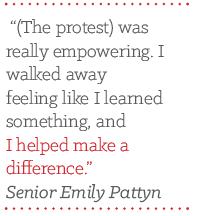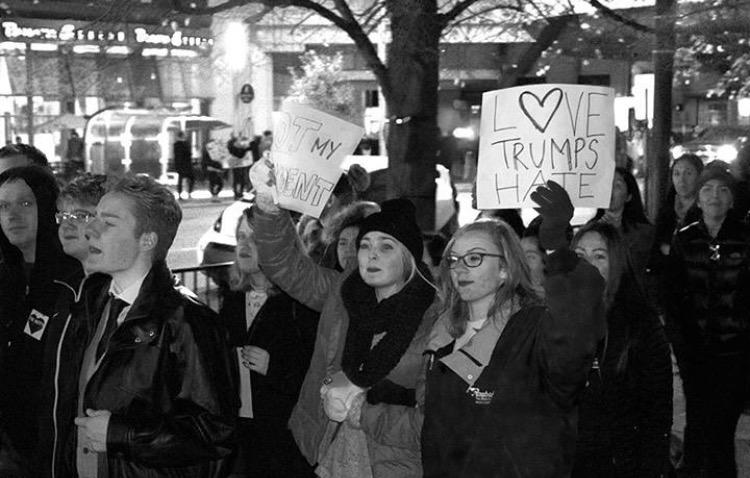Taking a leap of faith filled with democratic passion and a tinge of nervousness, Emily Pattyn, first time protest participant and senior, marched with hundreds of like-minded individuals from the Indiana State House to Monument Circle and back again on Nov. 12. Pattyn said she texted her mother asking for permission to participate in the anti-Donald Trump ally in response to the presidential election.
Pattyn said she went in eager to make posters and a difference after some persuasion by her friends and fellow protest-goers.
“We did this walk wrapping around Monument Circle. Right behind the leaders of the protest and the people who led the walk were drag queens, and right behind them were me and two other people; one started the whole event. We were getting ready to head back and (the organizer) started crying tears of joy. She was like, ‘Oh my God,’—because there was this whole crowd of people that still haven’t wrapped around the circle yet—‘I did this; we did this.’ It was a really great moment to share with someone who started the whole event we were all participating in. It was the highlight of my day,” Pattyn said.
In the U.S. Bill of Rights, the First Amendment includes freedoms of speech, press, religion, petition and peaceful assembly. According to Sandy Gardner, IB History of the Americas teacher, peaceful assembly, or protest, has deep roots within U.S. history, tracing back to before the founding of the country.
“Today, we’ve got en
vironmental issues, anti-globalism issues, occupy Wall Street; it’s just a continuation of how people feel they’re being represented by the government, which goes all the way back to the American Revolution,” said Gardner. “They didn’t feel like they were being represented by their government, and it’s the right of the people (to) abolish or to question government when they feel it’s not representing them properly.”
Pattyn said protesting against Trump was a way to make her individual voice join the voices of others.
She said, “I don’t know how to get (Trump) to see what Emily Pattyn wants, but I think having him see the struggles people go through (is positive), (like) if he were there to see the Black Lives Matter people speak about how they feel with someone against them running the country. I feel like a lot of those (internal) issues being brought up to him are (being ignored).”
Gardner said even though the Trump protests are different in the way that there haven’t been protests because of a difficult transition of power in a long time, protests against presidents and candidates are common; Harry Truman and John F. Kennedy are some examples of polarizing candidates during their election season.
Gardner said, “As much as people revere John F. Kennedy now, at the time that he was running for office he was criticized for being a Catholic and had to combat true protests and anti-Catholic sentiment that still existed in America at the time.”
Kaitlin Lange, former Indy Star breaking news reporter who covered the anti-Trump rally in November Pattyn attended, said it was her first time covering a protest professionally. Furthermore, she said there were multiple ideas and organizations the protesters went to support, people who she said were scared that they would be compromised in the following term.
For her part, Pattyn said, “I went for the whole purpose of climate change. I want a president who cares for my country and my planet and wants to help better the life of the planet.”
Jeff Kisling, a veteran peaceful assembly organizer, said he found his heart in standing up for environmental protection. He said key protests for him recently were Keystone XL and Dakota Access Pipeline (DAPL) that garnered national and international attention. Kisling said it had a common goal with a strong united front of supporters: stop the pipelines from developing.
Results from those protests were positive according to Kisling; Keystone XL was abandoned, DAPL is at a stall and some people terminated their PNC or Chase accounts because of the DAPL rallies. “We had a couple rallies to raise awareness and we also went to banks in town, PNC and Chase, who were financing the pipeline,” Kisling said.
 However, the idea of peaceful assembly isn’t new. According to Gardner, the modern era has influenced people to think that topics of recent protests are.
However, the idea of peaceful assembly isn’t new. According to Gardner, the modern era has influenced people to think that topics of recent protests are.
“The Dakota Pipeline issues of land for Native Americans (has) been going on for years but in different spots around the nation,” Gardner said. “It’s just that one’s a little bit more covered by the media, people are talking about it more. I think it’s a misrepresentation to say that it’s happening just right then. Most history classes (talk) about refugees from the Holocaust which is ironic (because it’s) also a pattern that we are dealing with very similar issues about Syrian refugees. People are having conversations about those similar types of issues today.”
Pattyn said although being on the fence about regularly protesting in the future, vocalizing her feelings and creating change are still important to her, so she is open to new avenues in college that pique her interests.
Pattyn said, “(The protest) was really empowering. I walked away feeling like I learned something.”

































![AI in films like "The Brutalist" is convenient, but shouldn’t take priority [opinion]](https://hilite.org/wp-content/uploads/2025/02/catherine-cover-1200x471.jpg)









































![Review: “The Immortal Soul Salvage Yard:” A criminally underrated poetry collection [MUSE]](https://hilite.org/wp-content/uploads/2025/03/71cju6TvqmL._AC_UF10001000_QL80_.jpg)
![Review: "Dog Man" is Unapologetically Chaotic [MUSE]](https://hilite.org/wp-content/uploads/2025/03/dogman-1200x700.jpg)
![Review: "Ne Zha 2": The WeChat family reunion I didn’t know I needed [MUSE]](https://hilite.org/wp-content/uploads/2025/03/unnamed-4.png)
![Review in Print: Maripaz Villar brings a delightfully unique style to the world of WEBTOON [MUSE]](https://hilite.org/wp-content/uploads/2023/12/maripazcover-1200x960.jpg)
![Review: “The Sword of Kaigen” is a masterpiece [MUSE]](https://hilite.org/wp-content/uploads/2023/11/Screenshot-2023-11-26-201051.png)
![Review: Gateron Oil Kings, great linear switches, okay price [MUSE]](https://hilite.org/wp-content/uploads/2023/11/Screenshot-2023-11-26-200553.png)
![Review: “A Haunting in Venice” is a significant improvement from other Agatha Christie adaptations [MUSE]](https://hilite.org/wp-content/uploads/2023/11/e7ee2938a6d422669771bce6d8088521.jpg)
![Review: A Thanksgiving story from elementary school, still just as interesting [MUSE]](https://hilite.org/wp-content/uploads/2023/11/Screenshot-2023-11-26-195514-987x1200.png)
![Review: "When I Fly Towards You", cute, uplifting youth drama [MUSE]](https://hilite.org/wp-content/uploads/2023/09/When-I-Fly-Towards-You-Chinese-drama.png)
![Postcards from Muse: Hawaii Travel Diary [MUSE]](https://hilite.org/wp-content/uploads/2023/09/My-project-1-1200x1200.jpg)
![Review: "Ladybug & Cat Noir: The Movie," departure from original show [MUSE]](https://hilite.org/wp-content/uploads/2023/09/Ladybug__Cat_Noir_-_The_Movie_poster.jpg)
![Review in Print: "Hidden Love" is the cute, uplifting drama everyone needs [MUSE]](https://hilite.org/wp-content/uploads/2023/09/hiddenlovecover-e1693597208225-1030x1200.png)
![Review in Print: "Heartstopper" is the heartwarming queer romance we all need [MUSE]](https://hilite.org/wp-content/uploads/2023/08/museheartstoppercover-1200x654.png)




